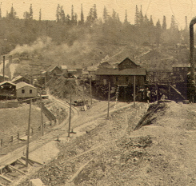The Problems with Fast Fashion
It’s not all that rare to find people willing to sacrifice in the name of fashion. Whether that means wearing uncomfortable heels despite the threat of blisters or deciding with reluctance to spend paychecks on the newest clothes and accessories. Regardless, many people are willing to sacrifice for fashion time and time again.
The weight of that sacrifice – usually in the name of a cute shirt or great bargain – is most evident when looking at the large scale phenomenon known as fast fashion. Fast fashion is when companies quickly manufacture and distribute clothing items to retailers – clothes that reflect passing trends or looks that are currently in style.
The clothes themselves are typically made and sold for incredibly low costs, but their quality is usually just as low as their price tags, making the clothing very disposable. The environmental ramifications of making and selling these clothes are also extensive and the working conditions leave more than a lot to be desired. They contribute to the growing pollution and textile waste problems as well.
In a society that thrives off of getting more – especially if it feels like more for the money – fast fashion seems like a perfect fit. People can walk into stores and pick up items that only cost a few dollars. They can leave with the knowledge that if their item falls apart or goes out of style, well, it won’t be too bad since it’s so cheap. In fact, they could probably go back in a couple of days and repeat the entire process with totally new options if they so desired. It seems great and convenient.
It’s true. It is incredibly convenient to do this, but the underlying process these cheap and trendy clothing items go through to get into consumer hands is something to seriously consider and be aware of.
For one, due to the fact that these clothes are made so quick and for so cheap, companies often cut environmental corners and use dyes and fabrics that don’t break down when disposed of. The materials can even contain toxic chemicals in some cases.
These are clothing items that are disposed of all the time, after all the whole idea is that people can get rid of them and replace them easily. They’re even marketed as such. However, disposing these clothes at the current rate creates incredible amounts of pollution and environmental issues. The clothes linger in landfills and water ways for long amounts of time, despite having a relatively low time of wear. Ultimately, companies produce waste by making these clothes in the bulk that they do and people wind up throwing them away at a pretty close rate.
Another point to bring up is the poor conditions and pay that workers experience when making these clothes. Many fast fashion producers are focused in developing countries where people are working in sweatshops and all but 2% are making less than the living wage while working for long amounts of time. Making and selling fast fashion is cheap, so it would make sense that worker pay is even less. It’s also very often unsafe and unsanitary for the workers (80% of whom are women and some of which who are children).
Despite all of this, the real problem is the ignorance of many on where clothes come from. Learning about the issue of fast fashion and researching the ethics of various stores creates a larger awareness and inspires many to think critically about whether or not they need to get rid of something and buy a new item. A lot of the problems surrounding fast fashion will never completely go away. However, by placing more value on clothes that are already owned, donating to and shopping at second hand stores, and reducing extraneous purchases, society can at least reduce the negative effects.
Hopefully just learning a bit more about the issue can lead to more well informed decisions in regard to fashion – after all, everyone will always need clothes.
Also, here are a couple of helpful links that relate to this topic.
- http://www.independent.co.uk/life-style/fashion/environment-costs-fast-fashion-pollution-waste-sustainability-a8139386.html
- https://www.esquire.com/style/news/a50655/fast-fashion-environment/
- https://www.theguardian.com/sustainable-business/2016/mar/08/fashion-industry-protect-women-unsafe-low-wages-harassment
- http://www.thegoodtrade.com/features/fair-trade-clothing










